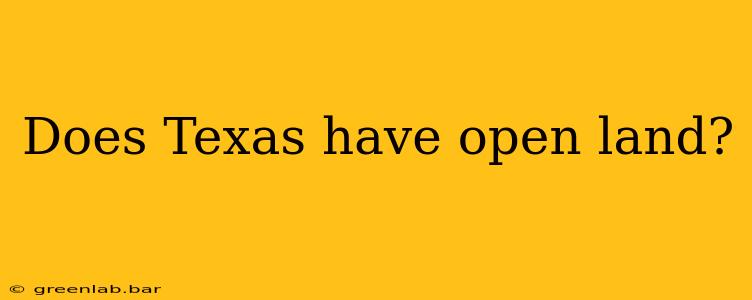Texas, the Lone Star State, conjures images of sprawling ranches, endless plains, and majestic deserts. But the question remains: Does Texas actually have open land, and if so, what kind? The answer is a resounding yes, but with important nuances. Understanding the reality of "open land" in Texas requires exploring its diverse geography and land ownership patterns.
Defining "Open Land" in Texas
Before diving in, let's clarify what we mean by "open land." It doesn't simply mean undeveloped land; it implies a sense of vastness, accessibility, and perhaps a feeling of remoteness. This could encompass:
-
Ranches and Agricultural Land: Texas is famous for its ranching heritage. Millions of acres are dedicated to cattle ranching, often featuring wide-open spaces interspersed with livestock and occasional structures. Much of this land is privately owned, but access may be available through hunting leases or guided tours.
-
State and National Parks: Texas boasts a diverse network of state and national parks, offering abundant opportunities for hiking, camping, and exploring the natural beauty of the state. These protected areas provide significant expanses of open land accessible to the public. Big Bend National Park, for example, is a prime example of vast, undeveloped desert landscape.
-
Wildlife Management Areas: Managed by the Texas Parks and Wildlife Department, these areas offer opportunities for hunting, fishing, and wildlife viewing, often across large tracts of relatively untouched land.
-
National Forests: While Texas has a relatively smaller area designated as national forests compared to other states, the existing ones still offer sizable tracts of open woodland.
The Reality of Open Land Ownership in Texas
While the image of wide-open spaces is prevalent, it's crucial to remember that much of this land is privately owned. This means access is often restricted, requiring permission or adherence to specific regulations. Public land, while significant, constitutes a fraction of the state's overall landmass.
Challenges to Accessing Open Land
-
Private Property Rights: Respecting private property is paramount. Trespassing is illegal and can result in serious consequences.
-
Remote Locations: Many areas of open land are located in remote regions, requiring considerable travel and potentially specialized equipment.
-
Weather Conditions: Texas' diverse climate presents challenges. Extreme heat in summer and occasional severe weather events can make access difficult and potentially dangerous.
-
Limited Infrastructure: Infrastructure, such as roads and facilities, is often less developed in areas with open land, impacting accessibility.
Finding Open Land in Texas: Resources and Considerations
If you're seeking to experience Texas' open spaces, consider these options:
-
Texas Parks and Wildlife Department: This agency manages numerous state parks and wildlife management areas, providing detailed information on access, fees, and regulations.
-
National Park Service: Explore national parks like Big Bend for breathtaking, vast landscapes.
-
Private Land Access Programs: Some organizations offer opportunities to access private land for recreational purposes, such as hunting or wildlife viewing. Always obtain proper permission.
Conclusion: A Land of Contrasts
Texas' open land is a significant part of its identity, but it's a complex reality shaped by private ownership and diverse geography. While vast stretches of open land exist, responsible exploration, respecting private property rights, and utilizing available resources are crucial for a safe and rewarding experience. Understanding these nuances allows for a more informed and appreciative engagement with the Lone Star State's unique landscapes.

